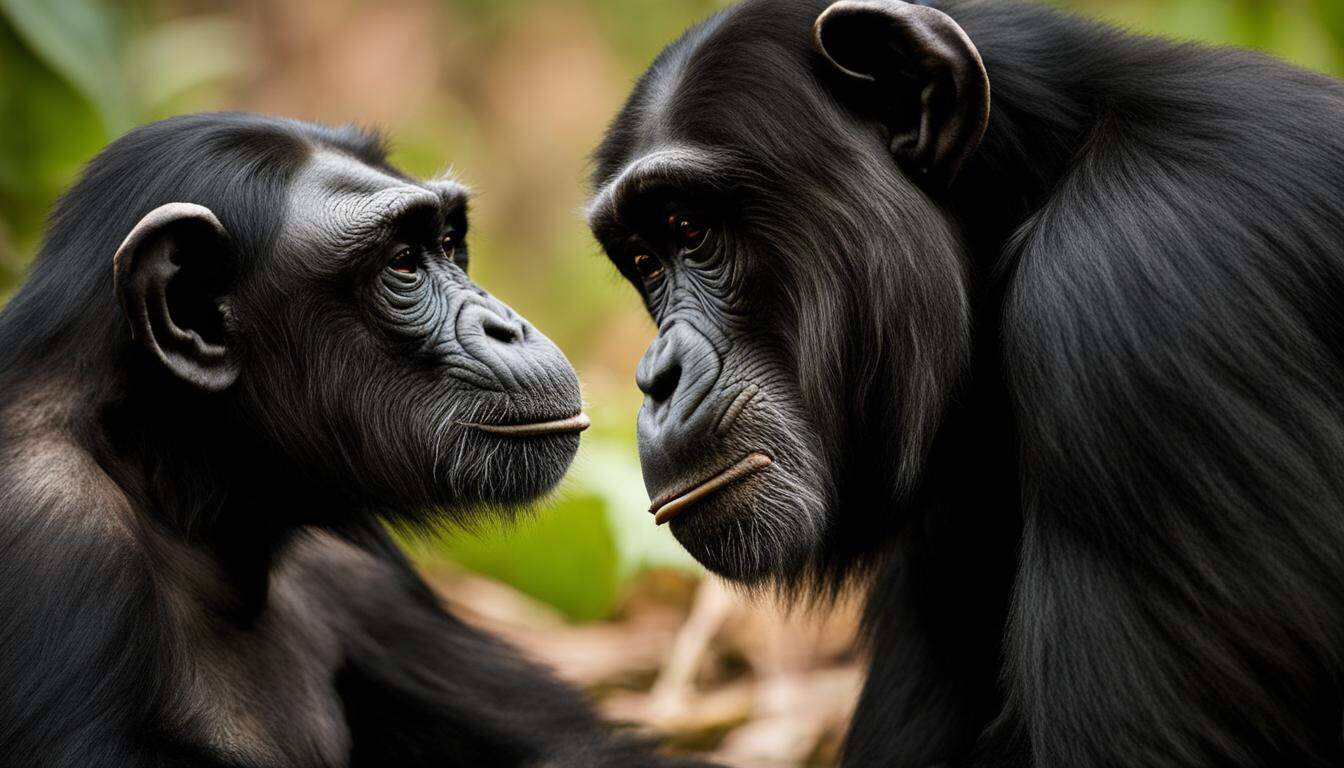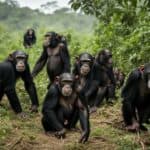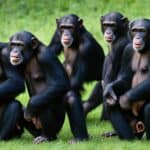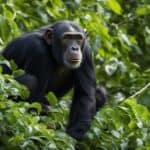Chimpanzees, our closest living relatives in the animal kingdom, have fascinating reproductive strategies. Understanding their mating behavior, reproductive system, and breeding habits gives us valuable insights into their reproduction cycle.
Chimpanzees breed all year round, with females experiencing a menstrual cycle similar to humans. They come into oestrus every 36 days, indicating their readiness to mate. During this time, females can mate with multiple males within their troop.
The gestation period for a chimpanzee is approximately 8 months, and females typically give birth every three to four years. While twin births are rare, the mother diligently takes care of her offspring for the first few years, carrying it everywhere on her back. The baby becomes independent at around six years old, marking an important milestone in their reproduction cycle.
Social Structure and Behavior of Chimpanzees
Chimpanzees are highly social animals and live in a fission-fusion society, where individuals belong to a larger community but travel and eat in smaller groups. This social structure allows for flexibility in interactions and resource sharing among chimpanzee troops. However, despite the fluidity, there is a clear, yet changeable, social hierarchy within chimpanzee groups.
Within a chimpanzee troop, there is typically an alpha male who holds the highest social status. The position of alpha male is often linked to his mother’s social standing within the group. The alpha male maintains his status through displays of dominance and aggression towards other males.
Grooming plays a crucial role in chimpanzee society. It is not only a means of hygiene but also serves as a form of social bonding. Chimpanzees engage in mutual grooming, where they pick through each other’s hair, removing dirt, parasites, and strengthening social bonds. Grooming sessions help reinforce alliances and establish trust among individuals in the group.
While chimpanzees are known for their cooperative behavior, they can also exhibit aggression. Interactions between different chimpanzee groups can result in territorial disputes and violent encounters. Aggression within the troop can also be observed during mating, where males may display aggressive behaviors towards females. These aggressive interactions are driven by competition for resources and reproductive opportunities.
Reproduction and Behavior in Bonobos
Bonobos, scientifically known as Pan paniscus, exhibit similar reproductive behaviors to chimpanzees. Female bonobos have pink genital swellings that indicate fertility, and they remain sexually receptive for a significant portion of their reproductive cycle. Bonobo mating can occur face-to-face or with the male positioned behind the female. Female bonobos typically give birth to their first offspring at around 13 or 14 years old, and the gestation period lasts approximately 8 months. Interestingly, bonobo females have been observed to nurse two infants simultaneously.
The reproductive strategies of bonobos are characterized by their unique social behaviors and sexual interactions. Sexual behavior in bonobos serves various social functions beyond reproduction. It helps build and strengthen social bonds, diffuse tension, and establish social hierarchies within their communities.
“Bonobos are known for their sexually promiscuous behavior, engaging in sexual acts between individuals of both sexes and in same-sex encounters. These interactions play a crucial role in creating a harmonious social structure and resolving conflicts within the bonobo community.”
Unlike most primates, including chimpanzees, bonobos have a relatively peaceful and matriarchal social structure. Female bonobos hold prominent positions within their communities, using their sexual interactions to establish and maintain social alliances. This unique social structure contributes to a more egalitarian and cooperative society among bonobos, in stark contrast to the aggression observed in chimpanzee communities.
Understanding the intricate reproductive behaviors and social dynamics of bonobos not only provides insights into their species but also highlights the importance of protecting their habitats and supporting conservation efforts. Bonobos face numerous threats, including habitat destruction, hunting, and disease, which necessitate proactive measures to ensure their survival and the preservation of their unique reproductive strategies.
Life Stages of Bonobos
Bonobo life stages involve distinctive periods of growth and development, shaping their behavior and social interactions. From infancy to adulthood, bonobos undergo crucial transitions on their journey towards reproductive maturity and independence.
Infancy:
Bonobo infants are highly dependent on their mothers during the first year of life. They cling closely to their mothers, who provide them with nourishment, protection, and care. This close bond fosters a strong sense of security and lays the foundation for future social relationships.
Juvenile:
As bonobos grow older, they gradually gain independence and explore their surroundings. The juvenile stage is characterized by increased curiosity and playfulness. During this phase, bonobos develop their physical skills, such as climbing and swinging through the trees, honing their abilities for survival in their natural habitat.
Adulthood:
At around 8 or 9 years old, bonobos reach sexual maturity and enter adulthood. They actively participate in social interactions and exhibit behaviors that contribute to the cohesiveness of their community. Mature bonobos demonstrate high tolerance towards younger individuals, facilitating a harmonious social structure within their groups.
Unlike chimpanzees, bonobos exhibit a phenomenon known as “delayed development,” meaning that their social and cognitive skills take longer to develop. This extended growth period contributes to unique behaviors, such as food sharing and complex communication, which are characteristic of bonobos.
The life expectancy of bonobos varies depending on various factors, including their habitat and quality of care. In managed care settings, the typical life expectancy for male bonobos is approximately 31.3 years.
“Bonobo life stages encompass important milestones, shaping their development and contributing to their social dynamics within the community.”
| Life Stage | Description |
|---|---|
| Infancy | High dependency on mother, forming a strong bond. |
| Juvenile | Developing physical skills and independence through exploration. |
| Adulthood | Reaching sexual maturity, engaging in social interactions, and exhibiting tolerance towards younger individuals. |
| Life Expectancy | Average life expectancy of approximately 31.3 years for male bonobos in managed care. |
Chimpanzees vs. Bonobos: Similarities and Differences in Reproduction
When it comes to reproduction, chimpanzees and bonobos, our closest living relatives, share many similarities. Both species have a polygynandrous mating system, which means that females mate with multiple males, and males mate with multiple females. Additionally, both chimpanzees and bonobos have a gestation period of approximately 8 months.
However, there are some notable differences in their reproductive behaviors. Bonobos, for example, have a more prolonged period of sexual receptivity compared to chimpanzees. Female bonobos are sexually receptive for a large portion of their reproductive cycle, often outside of their fertile phase.
Another difference lies in their social structures. Chimpanzees have a clear, yet changeable, social hierarchy, with an alpha male at the top. They exhibit high levels of aggression within and between groups. In contrast, bonobos have a more egalitarian and tolerant social structure, where aggression is less prevalent.
Understanding the similarities and differences in chimpanzee and bonobo reproduction provides valuable insights into their evolutionary history and helps us appreciate the fascinating range of behaviors exhibited by our primate relatives.
A Comparison of Chimpanzee and Bonobo Reproduction
| Aspect | Chimpanzees | Bonobos |
|---|---|---|
| Mating System | Polygynandrous | Polygynandrous |
| Gestation Period | Approximately 8 months | Approximately 8 months |
| Sexual Receptivity | Throughout the reproductive cycle, with fertile phases | Prolonged, often outside of fertile phase |
| Social Structure | Clear, changeable hierarchy; high aggression | More egalitarian; low aggression |
Reproduction and Conservation Efforts
Both chimpanzees and bonobos, two closely related species, are currently classified as endangered due to various threats they face in their natural habitats. These threats include habitat loss, illegal hunting, and diseases. To ensure the long-term survival of these remarkable creatures, conservation efforts have been implemented to protect their habitats, prevent poaching, and promote sustainable practices.
Chimpanzees and bonobos play vital roles in their respective ecosystems, functioning as keystone species. They contribute to the dispersal of plant seeds, help maintain forest health, and regulate prey populations. Protecting their reproductive cycles and behaviors is essential for the preservation of these species and the overall balance of their ecosystems.
Conservation organizations and governmental bodies have established protected areas and wildlife sanctuaries to safeguard the habitats of chimpanzees and bonobos. These initiatives aim to create safe havens where these animals can thrive and reproduce naturally, away from human disturbances. Additionally, educational programs are implemented to raise awareness about the importance of chimpanzee and bonobo conservation and to encourage sustainable practices that benefit both these species and local communities.
By supporting chimpanzee and bonobo conservation efforts, such as donating to reputable organizations or participating in eco-tourism activities, you can contribute to the protection of these endangered primates. Every action taken to protect their habitats and preserve their reproductive behaviors brings us one step closer to ensuring a brighter future for chimpanzees and bonobos.
What is the Reproduction Cycle of Chimpanzees and How Does it Affect Raising Offspring?
The raising chimpanzee offspring process involves a complex reproductive cycle. Female chimpanzees have a menstrual cycle similar to humans and typically give birth every 5-6 years. Offspring are raised by the mother and learn essential skills within their social group, emphasizing the importance of family in chimpanzee communities.
How Does the Reproduction Cycle of Chimpanzees Affect the Process of Raising Their Offspring?
The raising chimpanzee offspring process is highly influenced by the reproduction cycle of chimpanzees. Female chimps have an estrous cycle that determines their fertility, impacting the timing of pregnancy and birth. This, in turn, affects the availability of resources and the nurturing behaviors of the mother towards her offspring.







